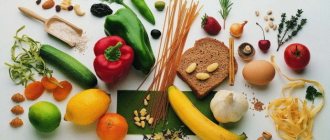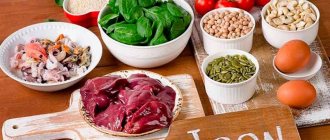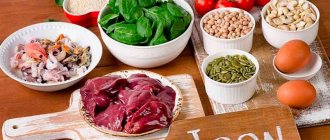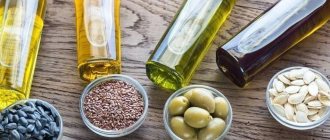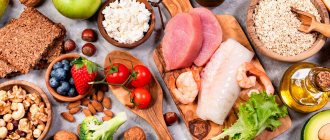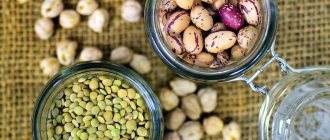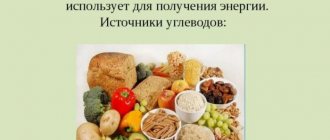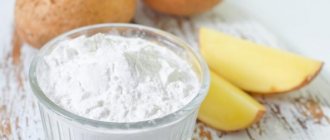Carbohydrates
Carbohydrates are the main suppliers of energy to the body: they provide the body with 50–60 percent of energy. Our brain especially needs carbohydrates.
It is also important that carbohydrates are an integral part of certain amino acid molecules involved in the formation of enzymes and nucleic acids.
Carbohydrates are divided into two groups:
- complex (or complex) - polysaccharides contained in natural products;
- simple (they are also called easily digestible) - monosaccharides and disaccharides, as well as isolated carbohydrates present in milk, some fruits and foods that have been chemically processed (in addition, carbohydrates of this group are found in refined sugar, as well as sweets).
It must be said that the human body in general and the brain in particular are mostly benefited by complex carbohydrates that come with protein foods. Such carbohydrates have long molecular chains, so their absorption takes a long time. As a result, carbohydrates do not enter the blood in large quantities, thereby eliminating the strong release of insulin, which leads to a decrease in blood sugar concentration.
There are three types of carbohydrates:
- monosaccharides;
- disaccharides;
- polysaccharides.
Monosaccharides
The main monosaccharides are glucose and fructose, consisting of one molecule, due to which these carbohydrates are quickly broken down and immediately enter the blood.
Brain cells are “fueled” with energy thanks to glucose: for example, the daily requirement of glucose required for the brain is 150 g, which is one fourth of the total volume of this carbohydrate received per day from food.
The peculiarity of simple carbohydrates is that they are quickly processed and are not transformed into fats, while complex carbohydrates (if consumed excessively) can be stored in the body as fat.
Monosaccharides are present in large quantities in many fruits and vegetables, as well as honey.
Disaccharides
These carbohydrates, which include sucrose, lactose and maltose, cannot be called complex, since they contain residues of two monosaccharides. Disaccharides require a longer time to digest compared to monosaccharides.
Interesting fact!
It has been proven that children and adolescents respond to increased consumption of carbohydrates found in refined (or refined) foods with so-called hyperactive (or hyperactive) behavior. By consistently eliminating foods such as sugar, white flour, pasta and white rice from your diet, behavioral disorders will decrease significantly. At the same time, it is important to increase the consumption of fresh vegetables and fruits, legumes, nuts, and cheese.
Disaccharides are present in dairy products, pasta and products containing refined sugar.
Polysaccharides
Polysaccharide molecules include tens, hundreds, and sometimes thousands of monosaccharides.
Polysaccharides (namely starch, fiber, cellulose, pectin, inulin, chitin and glycogen) are most important for the human body for two reasons:
- they take a long time to digest and absorb (unlike simple carbohydrates);
- contain many useful substances, including vitamins, minerals and proteins.
Many polysaccharides are present in plant fibers, as a result of which one meal, the basis of which is raw or boiled vegetables, can almost completely satisfy the body’s daily requirement for substances that are sources of energy. Thanks to polysaccharides, firstly, the required sugar level is maintained, and secondly, the brain is provided with the nutrition it needs, which is manifested by increased concentration, improved memory and increased mental activity.
Polysaccharides are found in vegetables, fruits, grains, meat, and animal liver.
Benefits of carbohydrates
- Stimulating peristalsis of the gastrointestinal tract.
- Absorption and elimination of toxic substances and cholesterol.
- Providing optimal conditions for the functioning of normal intestinal microflora.
- Strengthening the immune system.
- Normalization of metabolism.
- Ensuring proper liver function.
- Ensuring a constant supply of sugar in the blood.
- Prevention of the development of tumors in the stomach and intestines.
- Replenishment of vitamins and minerals.
- Providing energy to the brain, as well as the central nervous system.
- Promoting the production of endorphins, which are called “hormones of joy.”
- Relief of premenstrual syndrome.
Daily requirement of carbohydrates
The need for carbohydrates directly depends on the intensity of mental and physical activity, averaging 300–500 g per day, of which at least 20 percent should be easily digestible carbohydrates.
Elderly people should include no more than 300 g of carbohydrates in their daily diet, with the amount of easily digestible carbohydrates varying between 15 and 20 percent.
In case of obesity and other diseases, it is necessary to limit the amount of carbohydrates, and this should be done gradually, which will allow the body to adapt to the altered metabolism without any problems. It is recommended to start the restriction with 200 - 250 g per day for a week, after which the amount of carbohydrates consumed with food is increased to 100 g per day.
Important!
A sharp decrease in the consumption of carbohydrates over a long period of time (as well as their lack of nutrition) leads to the development of the following disorders:
- lowering blood sugar;
- significant decrease in mental and physical activity;
- weaknesses;
- weight loss;
- disruption of metabolic processes;
- constant drowsiness;
- dizziness;
- headaches;
- constipation;
- development of colon cancer;
- hand tremors;
- feeling hungry.
The listed phenomena disappear after eating sugar or other sweet foods, but the intake of such products should be dosed, which will protect the body from gaining extra pounds.
Important!
An excess of carbohydrates (especially easily digestible) in the diet is also harmful to the body, as it contributes to an increase in sugar, as a result of which some of the carbohydrates are not used, going to the formation of fat, which provokes the development of atherosclerosis, cardiovascular diseases, flatulence, diabetes, obesity, and caries.
What foods contain carbohydrates?
From the list of carbohydrates below, everyone can create a completely varied diet (taking into account the fact that this is not a complete list of foods that contain carbohydrates).
Carbohydrates are found in the following foods:
- cereals;
- apples;
- legumes;
- bananas;
- cabbage of different varieties;
- whole grain cereals;
- zucchini;
- carrots;
- celery;
- corn;
- cucumbers;
- dried fruits;
- eggplants;
- wholemeal bread;
- lettuce leaves;
- low-fat yogurt;
- corn;
- durum wheat pasta;
- onion;
- oranges;
- potatoes;
- plum;
- spinach;
- strawberries;
- tomatoes.
Only a balanced diet will provide the body with energy and health. But for this you need to properly organize your diet. And the first step to a healthy diet is a breakfast consisting of complex carbohydrates. So, a serving of whole grain porridge (without dressings, meat and fish) will provide the body with energy for at least three hours.
In turn, when consuming simple carbohydrates (we are talking about sweet baked goods, various refined foods, sweet coffee and tea), we experience an instant feeling of fullness, but at the same time a sharp rise in blood sugar occurs in the body, followed by a rapid decline, after which it appears again. hunger. Why is this happening? The fact is that the pancreas is very overloaded, since it has to secrete large amounts of insulin in order to process refined sugars. The result of such an overload is a decrease in sugar levels (sometimes below normal) and the appearance of a feeling of hunger.
To avoid these violations, let's consider each carbohydrate separately, determining its benefits and role in providing the body with energy.
List of foods high in carbohydrates
Table of carbohydrate content in foods.
| № | Amount of carbohydrates | Share of daily value per 100 g | |
| 1 | Fructose sugar substitute | 100.0 g | 32,3% |
| 2 | Stevia (sweetener) sugar substitute | 100.0 g | 32,3% |
| 3 | Granulated sugar | 100.0 g | 32,3% |
| 4 | Brown sugar | 98.1 g | 31,6% |
| 5 | Chewing gum | 96.7 g | 31,2% |
| 6 | Dried apples | 93.5 g | 30,2% |
| 7 | Fudge | 93.2 g | 30,1% |
| 8 | Corn starch | 91.3 g | 29,4% |
| 9 | Sucralose sugar substitute | 91.2 g | 29,4% |
| 10 | Skittles candy | 90.8 g | 29,3% |
| 11 | Iris | 90.4 g | 29,2% |
| 12 | Puffed rice ready to eat | 89.8 g | 29,0% |
| 13 | Saccharin sugar substitute | 89.1 g | 28,7% |
| 14 | Aspartame sugar substitute | 89.1 g | 28,7% |
| 15 | Dried plum low water content | 89.1 g | 28,7% |
| 16 | Dry tapioca | 88.7 g | 28,6% |
| 17 | Dried bananas | 88.3 g | 28,5% |
| 18 | Arrowroot flour | 88.2 g | 28,4% |
| 19 | Unheated corn bran | 85.6 g | 27,6% |
| 20 | Dried peach | 83.2 g | 26,8% |
| 21 | Potato starch | 83.1 g | 26,8% |
| 22 | Dried apricots low water content | 82.9 g | 26,7% |
| 23 | Dried cranberries | 82.8 g | 26,7% |
| 24 | Corn flour | 82.8 g | 26,7% |
| 25 | Honey | 82.4 g | 26,6% |
| 26 | Rye bread | 82.2 g | 26,5% |
| 27 | Dry glutinous (sticky) rice | 81.7 g | 26,3% |
| 28 | Zephyr (marshmallow) | 81.3 g | 26,2% |
| 29 | Dry potato flakes (instant puree) | 81.2 g | 26,2% |
| 30 | Dry steamed rice | 80.9 g | 26,1% |
| 31 | Cinnamon powder | 80.6 g | 26,0% |
| 32 | Dry rice noodles | 80.2 g | 25,9% |
| 33 | Rice flour | 80.1 g | 25,8% |
| 34 | Dry long grain rice | 80.0 g | 25,8% |
| 35 | Dry corn grits | 79.9 g | 25,8% |
| 36 | Puffed wheat ready to eat | 79.6 g | 25,7% |
| 37 | Dried carrots | 79.6 g | 25,7% |
| 38 | Seedless raisins | 79.5 g | 25,7% |
| 39 | Dry rice | 79.3 g | 25,6% |
| 40 | Dry corn noodles | 79.3 g | 25,6% |
| 41 | Pretzels without salt | 79.2 g | 25,5% |
| 42 | Dry round grain rice | 79.2 g | 25,5% |
| 43 | Onion powder | 79.1 g | 25,5% |
| 44 | Caramel popcorn | 79.1 g | 25,5% |
| 45 | Dry steamed brown rice | 78.7 g | 25,4% |
| 46 | Dried mango | 78.6 g | 25,3% |
| 47 | Malted barley flour | 78.3 g | 25,3% |
| 48 | Semolina dry semolina | 78.0 g | 25,2% |
| 49 | Popcorn without salt | 77.9 g | 25,1% |
| 50 | Salted popcorn | 77.8 g | 25,1% |
Whole carbohydrate table
Glucose
Glucose is rightfully considered the most important simple carbohydrate, which is the “building block” that participates in the construction of most food disaccharides and polysaccharides. This carbohydrate helps fats in the body “burn” in full.
Important!
In order for glucose to enter the cells, insulin is required, in the absence of which, firstly, the blood sugar level increases, and secondly, the cells begin to experience severe energy deficiency.
Glucose is the fuel that supports all processes in the body without exception. Thanks to this carbohydrate, proper functioning of the body is ensured under strong physical, emotional, and mental stress. Therefore, it is extremely important to maintain its normal level at a constant level.
The blood glucose level varies between 3.3 – 5.5 mmol/l (depending on age).
Benefits of glucose:
- providing the body with energy;
- neutralization of toxic substances;
- elimination of symptoms of intoxication;
- helping to cure diseases of the liver, gastrointestinal tract, cardiovascular, and nervous systems.
Lack or excess of glucose can lead to the development of the following disorders and diseases:
- changes in acid-base balance;
- disruption of carbohydrate-fat and protein metabolism;
- decrease or increase in blood pressure;
- diabetes mellitus;
- weaknesses;
- worsening mood.
What foods contain glucose?
Of the variety of carbohydrate-containing foods, the largest amount of glucose is present in grapes (for this reason, glucose is often called “grape sugar”).
In addition, glucose is found in the following foods:
- cherry;
- watermelon;
- cherries;
- melon;
- raspberries;
- strawberries;
- plum;
- carrot;
- banana;
- pumpkin;
- figs;
- White cabbage;
- potato;
- dried apricots;
- grains and cereals;
- raisin;
- pears;
- apples.
Glucose is also contained in honey, but only together with fructose.
Glucose absorption
The breakdown of carbohydrates is carried out under the action of digestive enzymes, especially salivary and pancreatic amylases. During the process of assimilation, carbohydrates undergo hydrolysis - they are converted into glucose, which is absorbed by the body - the only type of carbohydrates that the human body can use as a source of energy .
Glucose molecules are absorbed in the intestines or liver. Glucose is carried through the bloodstream to the tissues, where the chemical process of releasing energy from it occurs.
In response to rising blood glucose levels, the pancreas secretes insulin (but other factors also influence insulin secretion). Insulin acts as a glucose regulator, it lowers the level of glucose in the blood, and also delivers it and helps it penetrate into muscle and fat cells.
Different types of carbohydrates are absorbed differently because they have different chemical structures . To visualize this difference and the principles of digestion, the main steps for simple and complex carbohydrates are presented in the infographic below.
| Complex carbohydrates (especially dietary fiber), in turn, protect the body from increased levels of glucose in the blood and increased synthesis of insulin, which stimulates fat synthesis. |
As for simple carbohydrates, their frequent consumption can deplete the pancreas, disrupt carbohydrate metabolism and lead to type 2 diabetes. Also, increased insulin levels can stimulate the synthesis of fats, which are then stored in the so-called fat depots .
Fructose
Fructose is not only the most common, but also the most delicious carbohydrate, found in all sweet fruits and vegetables, as well as in honey.
The main advantage of fructose, whose calorie content is 400 kcal per 100 g, is that this carbohydrate is almost twice as sweet as sugar.
Important!
Unlike glucose, fructose does not need insulin to enter the blood and then into tissue cells: thus, fructose is removed from the blood in a fairly short period of time, so sugar rises much less than after consuming glucose. Thus, fructose can be consumed without harm to health by diabetics as a source of carbohydrates.
Benefits of fructose:
- normalization of blood sugar levels;
- strengthening the immune system;
- reducing the risk of caries, as well as diathesis;
- preventing the accumulation of carbohydrates;
- dulling of hunger;
- acceleration of recovery after intense physical and mental stress;
- reducing the caloric content of food.
Harm from fructose
Excessive consumption of fructose can trigger the development of diabetes, obesity and fatty liver. Why? This simple carbohydrate is the least likely (compared to other carbohydrates) to stimulate insulin production, which over time can cause immunity to this hormone, which is a kind of indicator that signals satiety. If insulin is not released, the body will not be able to assess a sufficient amount of energy, and, therefore, will continue to gain it, but in the form of fat deposits.
What foods contain fructose?
It is important to adhere to the average daily dose of fructose consumption, which for an adult is no more than 50 g.
Fructose is found in the following foods:
- corn syrup and its by-products;
- apples;
- grapes;
- dates;
- watermelons;
- pears;
- raisins;
- dried figs;
- blueberries;
- melon;
- persimmon;
- tomatoes;
- sweet red pepper;
- sweet onions;
- cucumbers;
- zucchini;
- white cabbage;
- honey;
- juices
Functions of carbohydrates in the body (biological role)
Carbohydrates are primarily used by the body as a source of energy. For example, the process of obtaining energy from glucose (the main and most universal carbohydrate for humans and animals) can be illustrated in a simplified way with the chemical formula:
C6H12O6 + 6O2 → 6H2O + 6CO2 + Energy.
Those. glucose is oxidized to form energy, water and carbon dioxide.
The body can also synthesize lipids and some amino acids from carbohydrates. And carbohydrates are part of some cell components.
Sucrose (sugar)
Sucrose is a well-known white sugar that is called an “empty carbohydrate” because it does not contain nutrients such as vitamins and minerals.
Today, discussions continue regarding the benefits and harms of this disaccharide. Let's try to understand this issue.
The benefits of sugar
- Ensuring normal brain function.
- Increased performance.
- Uplifting mood, which is important in modern life full of stress.
- Providing the body with energy (sugar is quickly broken down in the gastrointestinal tract into glucose and fructose, which are absorbed into the blood).
In turn, a deficiency of sugar in the body can cause irritation, dizziness and severe headaches.
The harm of sugar
- Metabolic disorders, which leads to the development of obesity and diabetes.
- Destruction of tooth enamel.
- Displacement of B vitamins from the blood, which can provoke sclerosis, heart attack and vascular diseases.
- Disruption of the musculoskeletal system.
- Brittle hair and nails.
- The appearance of acne and allergic rashes.
In addition, excessive love for sweets in children often develops into neuroses and causes hyperactivity.
What to do? Quit sugar completely? But the benefits of this carbohydrate are undeniable. There is a way out - and this is moderation in the use of this product.
During the research, the optimal daily intake of sugar was determined, which for an adult was 50–60 g, which corresponds to 10 teaspoons.
BUT!
The “norm” refers to both pure sugar and sugar contained in vegetables, fruits, juices, confectionery and other products that contain this carbohydrate. Therefore, you should consume sugar responsibly and carefully.
Important!
There is an alternative to white sugar - and this is brown sugar, which does not undergo any additional purification after separation from the raw materials (such sugar is also called unrefined). The calorie content of brown sugar is lower, while the biological value is higher. However, we should not forget that the difference between refined and unrefined sugar is not very large, so the consumption of both types should be moderate.
What foods contain sucrose?
Natural sources of sucrose in its pure form are sugar beets and sugar cane.
In addition, sucrose is present in sweet fruits, fruits, as well as berries and vegetables.
Glycemic index
Scientists have developed the theory that blood glucose levels are an important indicator of human health. of glycemic index originally came from .
The glycemic index (GI) was introduced in 1981 by Dr. David Jenkins of Toronto in an attempt to determine the most acceptable diet for diabetics. Since then, the nutritional principles implied by the glycemic index theory have become the subject of controversy among scientists.
| The glycemic index is a number that indicates the degree to which your blood glucose level (glycemic level) increases as a result of eating a food. |
The GI value is measured on a scale from 1 to 100. GI values for all food products studied are determined relative to the body’s response to pure glucose eaten (100 characterizes the effect of glucose). If the GI of white bread is 70, this means that the carbohydrate it contains is 70% hydrolyzed and will pass through the intestinal wall in the form of glucose.
A high glycemic index of a product means that as a result of its digestion, the rise in blood glucose levels will be significant.
A food's low glycemic index indicates that its absorption by the body will change glycemia slightly.
| Thus, with the same caloric content of consumed foods, the amount of glucose obtained from the breakdown of carbohydrates and entering the blood can vary significantly. |
University of Sydney nutrition professor Dr Jenny Brand-Miller and other scientists suggest that all carbohydrate-containing foods can be divided into three groups :
1. Low GI (GI ≤55): most fruits and vegetables, legumes, minimally processed grains, pasta, low-fat dairy, nuts.
2. Medium GI (GI = 56-69) : white and sweet potatoes, corn, white rice, couscous, semolina and other highly processed wheat cereals.
3. With high GI (GI ≥70) : white bread, rice cakes, sweet pastries, ready-made breakfast cereals.
Over the past three decades, researchers have measured the glycemic index of several thousand foods. In Russia, it is difficult to find a mention of GI on product packaging, but in European countries and the USA it is often indicated.
It is important to understand that the glycemic index is not a constant value . Its value depends on a number of parameters: origin, variety and variety of the product (for cereals, fruits), degree of ripening (for fruits), thermal and hydrothermal treatment, type of product processing (crushing, grinding to flour), as well as the individual characteristics of each person’s body and other factors.
The glycemic index of certain foods may also depend on what they are eaten with . Olive oil or something acidic, such as vinegar or lemon juice, can slow down the conversion of starch to sugar and thus lower the glycemic index.
| It makes no sense to look at just one parameter; it is necessary to look at the picture holistically. |
“Some foods (eg carrots, watermelon) have a high GI, but a standard serving contains so few carbohydrates that the effect on blood sugar levels is negligible. Others (such as soda) have a moderate GI because they contain enough fructose, which has a relatively minor effect on blood sugar. But they can also contain large amounts of glucose, which raises blood sugar levels,” warns Dr. Frank Hu, professor of nutrition and epidemiology at the Harvard School of Public Health.
Lactose
Lactose, called “milk sugar,” is a disaccharide that is broken down by the lactase enzyme in the intestine into glucose and galactose, which are absorbed by the body. This carbohydrate is found in milk and dairy products.
Benefits of lactose:
- providing the body with energy;
- facilitating calcium absorption;
- normalization of intestinal microflora due to the development of beneficial lactobacilli;
- stimulation of nervous regulation processes;
- prevention of the development of cardiovascular diseases.
Harm from lactose
This carbohydrate can cause harm when the human body lacks (or is present in insufficient quantities) the lactase enzyme, which promotes the digestibility of lactose. Lactase deficiency provokes milk intolerance and contributes to intestinal disorders.
Important!
If you are lactose intolerant, it is recommended to consume fermented milk products, in which most of this carbohydrate is fermented to lactic acid, which is well absorbed by the body.
Interesting fact!
Pure lactose is used in the production of various food products, dietary supplements and medicines aimed at preventing and treating dysbiosis.
What foods contain lactose?
As mentioned above, milk and dairy products are most enriched with lactose, containing up to 8 percent of this carbohydrate per 100 ml of product.
In addition, lactose is present in the following foods that everyone loves:
- bread;
- products for diabetics;
- confectionery;
- powdered milk;
- whey and related by-products;
- condensed milk;
- margarine;
- ice cream;
- coffee cream (both dry and liquid);
- sauces and salad dressings (ketchup, mustard, mayonnaise);
- cocoa powder;
- flavor enhancers.
Lactose is not contained in the following products:
- coffee;
- fish;
- tea;
- soybean and its by-products;
- fruits;
- vegetables;
- eggs;
- nuts;
- vegetable oils;
- legumes and grains;
- meat.
Relative sweetness of carbohydrates
When we eat simple carbohydrates, we experience sweetness. If we take the sweetness of sucrose as 100, then the sweetness of fructose will be 173, and the sweetness of glucose will be 74.3.
| Relative sweetness | Percentage of fructose | |
| Lactose | 16,0 | 9.2% |
| Galactose | 32,1 | 18.6% |
| Maltose | 32,5 | 18.8% |
| Glucose | 74,3 | 42.9% |
| Honey | 97,0 | 56.1% |
| Sucrose | 100,0 | 57.8% |
| Fructose | 173,0 | 100% |
Maltose
“Malt sugar” is what the natural disaccharide maltose is often called.
Malt sugar is a product of the natural fermentation of malt contained in sprouted, dried and ground cereal crops (we are talking about rye, rice, oats, wheat and maize).
This sugar has a less cloying and sweet taste (unlike cane and beet sugar), due to which it is used in the food industry in the manufacture of:
- baby food;
- muesli;
- beer;
- confectionery products;
- dietary products (for example, cookies and crispbread);
- ice cream
In addition, it is maltose that is used in the production of molasses, which is an integral component of beer.
Maltose is not only an excellent source of energy, but also a substance that helps the body obtain B vitamins, fiber, amino acids, macro- and microelements.
This disaccharide can cause harm if it is consumed excessively.
What foods contain maltose?
Maltose is present in large quantities in sprouted grains.
In addition, small amounts of this carbohydrate are found in tomatoes, oranges, yeast, honey, molds, as well as in pollen, seeds and nectar of some plants.
Products without carbohydrates
A healthy menu should include slow carbohydrate compounds, that is, those that are absorbed gradually. It is better to prepare porridge from unprocessed cereals, using water rather than milk. Eat without sugar. You should not give up bran and muesli, because they are absorbed slowly and improve the functioning of the digestive system. Peas, beans, chickpeas, and lentils contain slow carbohydrate compounds, so they can be safely included in the diet. The lack of sweet taste will help identify foods that have a low glycemic index. A healthy menu should include low carbohydrate foods. These are vegetable, fruit, dairy products, herbs, nuts.
In addition to foods low in carbohydrates, there are foods that do not contain them at all.
- Meat: chicken, turkey, rabbit, veal, pork, lamb tenderloin.
- Liver: liver, kidneys, heart.
- Fish: river, sea, low-fat varieties.
- Seafood: shrimp, crab, squid.
- Vegetable oil: sunflower, olive, sesame.
- Mushrooms. Only porcini mushrooms and boletus mushrooms contain a small amount: no more than 1-2 grams per 100 grams of product.
- Cheese: Roquefort, Brie, Cheddar, Parmesan, Tilsiter and others.
- Alcoholic drinks: vodka, cognac, gin, brandy, rum.
Starch
Starch belongs to the class of complex carbohydrates with high energy value and easy digestibility. This polysaccharide, passing through the gastrointestinal tract, is transformed into glucose, which is absorbed in a maximum of 4 hours. It is starch that accounts for about 80 percent of carbohydrates consumed in food.
But!
To maximize the absorption of this carbohydrate, it is not recommended to consume it simultaneously with protein products, the digestion of which requires alkaline acid (it is also necessary for the absorption of starch, which provokes the deposition of fat in cells). In order for the absorption of starchy vegetables to take place optimally, and for the body to receive the required amount of vitamins and microelements, the consumption of starch should be combined with the intake of fats contained in vegetable oil, cream and sour cream.
Benefits of starch:
- reduction of cholesterol in the blood serum, as well as in the liver, which prevents the development of sclerosis;
- removing excess water from the body;
- relieving inflammatory processes, which is especially important for people with ulcers;
- normalization of digestion;
- normalization of metabolism;
- slowing down the absorption of sugar, which helps reduce its level after eating;
- reduction of skin irritations.
Harm of starch
Starches can be natural (found in natural products) and refined (obtained under industrial production conditions). It is refined starch that is harmful, increasing inulin during digestion and promoting the development of atherosclerosis, pathology of the eyeball, metabolic disorders and hormonal balance.
Therefore, if possible, you should exclude from your diet products that contain powdered starch (one of these products is bread made from premium flour).
Important!
Consumption of excessive amounts of natural starch can lead to flatulence, bloating and stomach cramps.
What foods contain starch?
Starch is found in large quantities in grains and legumes, cereals, pasta, mangoes, bananas, root vegetables, and tubers.
Starch is also present in the following products:
- zucchini;
- carrots;
- rye, rice, corn and wheat flour;
- beets;
- potatoes;
- oat and corn flakes;
- soybean and its by-products;
- bread;
- horseradish;
- ginger;
- garlic;
- pumpkin;
- artichokes;
- kohlrabi;
- chicory;
- mushrooms;
- sweet pepper;
- parsley and celery root;
- radish.
Important!
To preserve the nutritional and beneficial properties of starch, it is recommended to steam starchy foods or eat them fresh.
Important!
Heat-treated foods containing starch are more difficult to digest than raw foods.
Interesting fact!
To check whether a vegetable or fruit contains starch, you can do a simple test that involves dropping a drop of iodine onto a cut of the vegetable or fruit. If after a few minutes the drop turns blue, it means that the product being tested contains starch.
Glycemic load
In addition to GI, nutritionists also proposed to take into account the glycemic load of foods (GL) .
Glycemic load (GL) takes into account both the GI of a product and the amount of carbohydrates in it. Often foods with a high GI will have a low GI. Formula for calculating GBV:
Example:
- Ready zucchini (GI=75). GN = 75*4.9/100 = 3.68.
- Wheat bagel (GI=72). GN = 72*58.5/100=42.12.
Scale of GBV levels:
- GN≤10 – minimum level;
- GN = 11-19 – moderate level;
- GN ≥20 – increased.
In recent years, an opinion has emerged in the scientific community about the need to revise the assessment of GI.
Research shows that GI and GL are not sufficiently reliable criteria for choosing carbohydrate-containing products, since they do not allow highly accurate optimization of glucose levels when preparing a diet.
| These indicators do not take into account the individual characteristics of the body and the conditions for the formation of the diet (process and conditions of preparation of products, list of all products, etc.). |
Therefore, scientists have introduced new concepts - insulin index and insulin load, which are also not universal, but allow us to obtain a more complete picture of the effect of a product on the human body. We will definitely devote one of our future articles to these concepts.
Cellulose
Fiber, which belongs to the class of polysaccharides, is a fiber that forms the basis of plants (this includes fruits and vegetables, berries and root vegetables).
Important!
Fiber is practically not absorbed into the intestines, but at the same time takes an active part in normalizing the functioning of the gastrointestinal tract.
Benefits of fiber:
- formation of feces;
- improvement of intestinal motor function;
- prevention of constipation;
- promoting the elimination of cholesterol;
- improved bile secretion;
- dulling of hunger;
- absorption and removal of waste and toxins;
- promoting the digestion of carbohydrates;
- prevention of cardiovascular diseases and colon cancer;
- preventing the formation of gallstones;
- maintaining normal intestinal microflora;
- helping to reduce fat layers.
Important!
Fiber prevents the rapid absorption of the monosaccharide glucose in the small intestine, thereby protecting the body from sudden changes in blood sugar.
What foods contain fiber?
The required daily intake of pure fiber (that is, without taking into account the mass of the product from which this carbohydrate is obtained) is at least 25 g.
Fiber is found in large quantities in the outer coverings of grains, seeds and beans, as well as in the peels of vegetables and fruits (especially citrus fruits).
In addition, this polysaccharide is found in the following foods:
- bran;
- cereals;
- nuts;
- seeds;
- berries;
- bakery products made from wholemeal flour;
- dried fruits;
- greenery;
- carrots;
- cabbage of different varieties;
- green apples;
- potatoes;
- seaweed.
Important!
Fats, sugar, dairy products, cheeses, meats and fish do not contain fiber.
Structure and functions of lipids
Lipids do not have a single chemical characteristic. In most textbooks, when defining lipids , they say that this is a group of water-insoluble organic compounds that can be extracted from cells with organic solvents - ether, chloroform and benzene. Lipids can be divided into simple and complex.
Simple lipids are mostly represented by esters of higher fatty acids and trihydric alcohol glycerol - triglycerides. Fatty acids have: 1) a group that is the same for all acids - a carboxyl group (–COOH) and 2) a radical by which they differ from each other. The radical is a chain of varying numbers (from 14 to 22) of –CH2– groups. Sometimes a fatty acid radical contains one or more double bonds (–CH=CH–), such a fatty acid is called unsaturated . If a fatty acid has no double bonds, it is called saturated . When a triglyceride is formed, each of the three hydroxyl groups of glycerol undergoes a condensation reaction with a fatty acid to form three ester bonds.
saturated fatty acids predominate in triglycerides , then at 20°C they are solid; they are called fats and are characteristic of animal cells. unsaturated fatty acids predominate in triglycerides , then at 20 ° C they are liquid; they are called oils and are characteristic of plant cells.
1 - triglyceride; 2 - ester bond; 3 - unsaturated fatty acid; 4 — hydrophilic head; 5 - hydrophobic tail.
The density of triglycerides is lower than that of water, so they float in water and are located on its surface.
Simple lipids also include waxes - esters of higher fatty acids and high molecular weight alcohols (usually with an even number of carbon atoms).
Complex lipids . These include phospholipids, glycolipids, lipoproteins, etc.
Phospholipids are triglycerides in which one fatty acid residue is replaced by a phosphoric acid residue. Take part in the formation of cell membranes.
Glycolipids - see above.
Lipoproteins are complex substances formed as a result of the combination of lipids and proteins.
Lipoids are fat-like substances. These include carotenoids (photosynthetic pigments), steroid hormones (sex hormones, mineralocorticoids, glucocorticoids), gibberellins (plant growth substances), fat-soluble vitamins (A, D, E, K), cholesterol, camphor, etc.
Cellulose
Cellulose is the main building material used in the plant world: for example, the soft upper part of plants predominantly contains cellulose, which contains elements such as carbon, oxygen, and hydrogen.
Cellulose is a type of fiber.
Important!
Cellulose is not digested by the human body, but it is extremely useful for it as “roughage”.
The benefits of cellulose
Cellulose perfectly absorbs water, thereby facilitating the work of the colon, which helps to effectively combat the following disorders and diseases:
- constipation;
- diverticulosis (formation of pouch-shaped protrusions of the intestinal wall);
- spasmodic colitis;
- haemorrhoids;
- colon cancer;
- phlebeurysm.
What foods contain cellulose?
The following products are enriched with cellulose:
- apples;
- beet;
- Brazil nuts;
- cabbage;
- carrot;
- celery;
- green beans;
- pear;
- peas;
- uncrushed cereals;
- bran;
- pepper;
- lettuce leaves.
physical characteristics
All carbohydrates perform an energy function using glucose and glycogen. Some amino acids, lipids, and pentoses can be synthesized from Cn(H2O)m. Carbohydrates are used as the main structural and functional component of cells. Among the main physicochemical properties of Cn (H2O)m are:
- Monosaccharides dissolve best in H2O. These organic compounds are used to produce syrups, from which it is difficult to isolate C6H12O6 in crystalline form.
- Cn(H2O)m are transparent and exhibit neutral pH in solution.
- Among carbohydrates, there are simple compounds with a molecular weight of 200 g/mol and large polymers, the mass of which can reach several million.
- As a result of the oxidation of C6H12O6, acids can be obtained. This chemical reaction is in demand in pharmacology. If an ammonia solution of silver oxide hydrate is used to oxidize glucose, then C6H12O7 (“silver mirror”) can be obtained.
- Polyhydric alcohols are formed as a result of the reduction of sugars. This reaction can use hydrogen in the presence of Ni and Li[AlH4].
- When using gaseous HCl and under the influence of CH3OH, the hydrogen atom of the glycolysis hydroxyl can be replaced by a methyl group.
If glucose is exposed to acetic anhydride, then pentaacetyl glucose (ester) will be formed.
Pectin
From Greek, the name of this carbohydrate, which is a type of fiber, is translated as “curdled” or “frozen.” Pectin is an adhesive substance exclusively of plant origin.
Entering the body, pectin performs a dual function: firstly, it removes harmful cholesterol, toxins and carcinogens; secondly, it provides tissues with glucose, which reduces the risk of developing cardiovascular diseases, diabetes and cancer.
Benefits of pectin:
- stabilization of metabolism;
- improvement of peripheral blood circulation;
- normalization of intestinal motility;
- elimination of manifestations of chronic intoxication;
- enriching the body with organic acids, vitamins and minerals;
- slowing down the absorption of sugar after eating food, which is extremely useful for people with diabetes.
In addition, this carbohydrate has enveloping, astringent, anti-inflammatory and analgesic properties, making it suitable for people with gastrointestinal disorders and peptic ulcers.
Harm of pectin
Excessive consumption of pectin may cause the following reactions:
- decreased absorption of beneficial minerals such as iron, calcium, magnesium and zinc;
- fermentation in the colon, accompanied by flatulence and decreased digestibility of proteins and fats.
Important!
With natural products, pectin enters the body in small doses that cannot lead to an overdose, while this polysaccharide can cause harm to health with excessive consumption of dietary supplements.
What foods contain pectin?
The daily intake of pectin in its pure form is about 20 - 30 g. If the diet is enriched with fruits, vegetables and herbs, then there is no need to obtain pectin from synthetic additives.
List of products containing pectin:
- apples;
- citrus;
- carrot;
- cauliflower and white cabbage;
- dried peas;
- green beans;
- potato;
- greenery;
- strawberries;
- strawberry;
- roots.
Carbohydrates and bodybuilding: who, what, how much
A few words about the glycemic index
When talking about carbohydrates, one cannot help but mention the term “glycemic index” - that is, the rate at which carbohydrates are absorbed. It is an indicator of how quickly a particular product can increase the amount of glucose in the blood. The highest glycemic index is 100 and refers to glucose itself. The body, after consuming food with a high glycemic index, begins to store calories and deposits fat deposits under the skin. So all foods with high GI values are sure companions for rapidly gaining extra pounds.
Products with a low GI index are a source of carbohydrates, which for a long time, constantly and evenly nourishes the body and ensures a systematic flow of glucose into the blood. With their help, you can properly adjust your body to a long-term feeling of satiety, as well as prepare your body for active physical activity in the gym. There are even special tables for foods that indicate the glycemic index (see image).
The body's need for carbohydrates and the right sources
Now the moment has come when we figure out how many carbohydrates we need to consume in grams. It is logical to assume that bodybuilding is a very energy-consuming process. Therefore, if you want the quality of your training not to suffer, you need to provide your body with a sufficient amount of “slow” carbohydrates (about 60-65%).
It is difficult to give specific recommendations regarding a clear amount, since it all depends on:
- Duration of training;
- Load intensity;
- Metabolic rates in the body.
It is important to remember that you do not need to go below the level of 100g per day, and also have 25-30g in reserve, which is fiber.
Remember that an ordinary person consumes about 250-300g of carbohydrates per day. For those who train in the gym with weights, the daily norm increases and reaches 450-550g. But they still need to be used correctly, and at the right time (in the first half of the day). Why do you need to do this? The scheme is simple: in the first half of the day (after sleep), the body accumulates carbohydrates in order to “feed” its body with them (which is necessary for muscle glycogen). The remaining time (after 12 hours) carbohydrates are quietly deposited in the form of fat. So stick to the rule: more in the morning, less in the evening. After training, it is important to adhere to the rules of the protein-carbohydrate window.
Important : the protein-carbohydrate window is a short period of time during which the human body becomes able to absorb an increased amount of nutrients (used to restore energy and muscle reserves).
It has already become clear that the body needs to constantly receive nourishment in the form of “correct” carbohydrates. To understand the quantitative values, consider the table below.
The concept of “correct” carbohydrates includes those substances that have high biological value (amount of carbohydrates/100 g of product) and a low glycemic index. These include products such as:
- Baked or boiled potatoes in their skins;
- Various porridges (oatmeal, pearl barley, buckwheat, wheat);
- Bakery products made from wholemeal flour and bran;
- Pasta (from durum wheat);
- Fruits that are low in fructose and glucose (grapefruits, apples, pomelo);
- Vegetables are fibrous and starchy (turnips and carrots, pumpkin and zucchini).
These are the foods that should be present in your diet.
The ideal time to consume carbohydrates
The best time to consume a dose of carbohydrates is:
- Time after morning sleep;
- Before training;
- After training;
- During training.
Moreover, each of the periods is important and among them there is no more or less suitable one. Also in the morning, in addition to healthy and slow carbohydrates, you can eat something sweet (a small amount of fast carbohydrates).
Before you go to training (2-3 hours before), you need to fuel your body with carbohydrates with average glycemic index values. For example, eat pasta or corn/rice porridge. This will provide the necessary energy supply for the muscles and brain.
During classes in the gym, you can use intermediate nutrition, that is, drink drinks containing carbohydrates (200 ml every 20 minutes). This will have double benefits:
- Replenishment of fluid reserves in the body;
- Replenishment of muscle glycogen depot.
After training, it is best to take a saturated protein-carbohydrate shake, and 1-1.5 hours after completing the training, eat a hearty meal. Buckwheat or pearl barley porridge or potatoes are best suited for this.
Now is the time to talk about the role carbohydrates play in the muscle building process.
Do Carbohydrates Help You Build Muscle?
It is generally accepted that only proteins are the building material for muscles and only they need to be consumed in order to build muscle mass. In fact, this is not entirely true. Moreover, carbohydrates not only help in building muscle, they can help you lose extra pounds. But all this is possible only if they are consumed correctly.
Important : in order for 0.5 kg of muscle to appear in the body, you need to burn 2500 calories. Naturally, proteins cannot provide such an amount, so carbohydrates come to the rescue. They provide the necessary energy to the body and protect proteins from destruction, allowing them to act as building material for muscles. Carbohydrates also promote rapid fat burning. This happens due to the fact that a sufficient amount of carbohydrates contributes to the consumption of fat cells, which are constantly burned during exercise.
It must also be remembered that depending on the level of training of the athlete, his muscles can store a larger supply of glycogen. To build muscle mass, you need to take 7g of carbohydrates for every kilogram of body. Don’t forget that if you start taking more carbohydrates, then the intensity of the load should also be increased.
So that you fully understand all the characteristics of nutrients and understand what and how much you need to consume (depending on age, physical activity and gender), carefully study the table below.
- Group 1 – predominantly mental/sedentary work.
- Group 2 – service sector/active sedentary work.
- Group 3 – medium-heavy work – mechanics, machine operators.
- Group 4 – hard work – builders, oil workers, metallurgists.
- Group 5 – very hard work – miners, steelworkers, loaders, athletes during the competitive period.
Inulin
Inulin belongs to the class of natural polysaccharides. Its effect is similar to that of a prebiotic, that is, a substance that, almost without being adsorbed in the intestines, activates metabolism and the growth of beneficial microflora.
Important!
Insulin is 95 percent fructose, one of the functions of which is to bind glucose and remove it from the body, thereby reducing the concentration of sugar in the blood.
Benefits of inulin:
- removal of toxins;
- normalization of the gastrointestinal tract;
- improved absorption of both vitamins and minerals;
- strengthening the immune system;
- reducing the risk of developing cancer;
- eliminating constipation;
- improved insulin absorption;
- preventing the formation of blood clots;
- normalization of blood pressure;
- promoting the excretion of bile.
Important!
Inulin is easily absorbed by the human body, as a result of which it is used in medicine for diabetes mellitus as a substitute for starch and sugar.
What foods contain inulin?
Jerusalem artichoke is rightfully recognized as the leader in inulin content, the edible tubers of which, in their taste, resemble the familiar taste of potatoes. Thus, Jerusalem artichoke tubers contain about 15–20 percent inulin.
In addition, inulin is found in the following products:
- garlic;
- chicory;
- banana;
- dandelion;
- echinacea;
- onion;
- barley;
- rye;
- burdock;
- elecampane;
- agave.
Interesting fact!
Today, inulin is actively used in the production of many food products and drinks: ice cream, cheeses, meat products, muesli, sauces, juices, baby food, bakery, pasta and confectionery products.
Classification of carbohydrates
Based on their chemical composition, carbohydrates are divided into two main groups: simple and complex sugars. From the point of view of digestibility by the human body, carbohydrates can be digestible and indigestible.
Simple carbohydrates (simple saccharides) are the final product that does not require additional breakdown and is absorbed by the body almost completely.
Simple carbohydrates:
- Glucose (grape sugar, dextrose). It is found in the juice of many fruits and berries, honey, and in some vegetables (pumpkin, carrots, white cabbage). Glucose is half as sweet as sucrose.
- Fructose (fruit sugar). Sugar contained in honey and fruits (especially a lot in grapes). Fructose is one of the sweetest carbohydrates. This monosaccharide is added to a huge number of processed foods and convenience foods.
- Galactose. Contained in milk. Galactose is rarely used as a sweetener, since it has two-thirds less sweetness than regular sugar.
- Sucrose. The most common disaccharide, common table sugar. Sucrose is made from sugar cane and sugar beets.
- Maltose (malt sugar). Contained in large quantities in sprouted grains (malt) of barley, rye and other grains; also found in tomatoes, pollen and nectar of a number of plants.
- Lactose (milk sugar).
Complex carbohydrates (polysaccharides) are complex compounds of a large number of monosaccharides. It is important for us to divide them into two groups:
1. Digestible polysaccharides - starch and glycogen - are broken down by body enzymes.
Starch is found in all plant foods, but its amount varies. The largest amount of starch is found in products made from wheat flour (pasta, bread), cereals, potatoes and legumes.
2. Indigestible polysaccharides , which are also collectively called fiber (dietary fiber), are not processed by the body.
| Numerous studies have shown that high levels of fiber in the diet promote long-term feelings of fullness, weight loss, lower blood cholesterol levels, reduce the risk of diabetes and increase beneficial intestinal microflora. |
The main source of such polysaccharides are products of plant origin.
Types of dietary fiber:
1. Insoluble dietary fiber.
Cellulose (fiber) and lignin. Fiber is the most common type of dietary fiber. Sources of insoluble dietary fiber are bran, cereals and grains, raw vegetables (cabbage, carrots, radishes), peels of apples, tomatoes, grapes, legumes and some nuts and seeds.
2. Soluble dietary fiber.
Pectin, hemicellulose, gum, etc. Soluble dietary fiber is found in legumes (peas, soybeans, beans), cereals (oats, barley, rye), vegetables (broccoli, carrots), berries and fruits (especially cherries, plums and apples ), as well as in citrus fruits and their peels.
Carbohydrates are found in most foods. The optimal sources of the considered types of carbohydrates and their volumes from the point of view of forming a complete diet are presented in the diagram.
Chitin
Chitin (translated from Greek “chitin” means “clothing”) is a substance that is part of the exoskeleton of both arthropods and insects.
Interesting fact!
Chitin is one of the most common polysaccharides in nature: for example, every year on planet Earth, about 10 gigatons of this substance are formed and decomposed in living organisms.
Important!
In all organisms that produce and use chitin, it is not present in pure form, but only in combination with other polysaccharides.
Benefits of chitin:
- protection from radioactive radiation;
- suppression of the growth of cancer cells by neutralizing the effects of carcinogens and radionuclides;
- prevention of heart attacks and strokes by enhancing the effect of blood thinners;
- strengthening the immune system;
- lowering blood cholesterol levels, which prevents the development of atherosclerosis and obesity;
- improved digestion;
- stimulating the growth of beneficial bifidobacteria, which contributes to the normalization of the gastrointestinal tract;
- elimination of inflammatory processes;
- acceleration of tissue regeneration processes;
- lowering blood pressure;
- reduction in blood sugar.
What foods contain chitin?
Chitin is found in its pure form in the exoskeleton of crabs, shrimp and lobsters.
In addition, this substance is present in certain types of algae, mushrooms (the most popular among our compatriots are honey mushrooms and oyster mushrooms), and yeast. By the way, the wings of butterflies and ladybugs also contain chitin.
But that’s not all: for example, in Asian countries, the lack of chitin is compensated by eating locusts, crickets, beetles and their larvae, worms, grasshoppers, caterpillars and cockroaches.
Benefits of carbohydrates
Carbohydrates in foods, when consumed correctly, have many beneficial properties:
- maintain normal body weight;
- increase insulin production;
- stimulate brain activity;
- improve health;
- reduce the amount of cholesterol.
In the modern world, nutritionists have come up with many diets that are based on the proper consumption of carbohydrates. There is an opinion that to lose weight it is better to consume complex carbohydrates - and then losing weight will only bring pleasure.
Glycogen
Glycogen (this carbohydrate is also called “animal starch”) is the main form of glucose storage, and this kind of “conserved energy” can make up for glucose deficiency in a short period of time.
What is it about? Carbohydrates that enter the body with food, when passing through the digestive tract, are broken down into glucose and fructose, which provide human systems and organs with energy. But some of these monosaccharides enter the liver, depositing it in the form of glycogen.
Important!
It is glycogen, “preserved” in the liver, that has an important role in maintaining the concentration of glucose in the blood at the same level.
Important!
Glycogen concentrated in the liver is almost completely depleted 10 to 17 hours after eating, while the content of muscle glycogen decreases significantly only after prolonged and intense physical activity.
A decrease in glycogen concentration is signaled by a feeling of fatigue. As a result, the body begins to receive energy from fat or muscle, which is extremely undesirable for those who purposefully increase muscle mass.
Spent glycogen must be replenished within one to two hours, which will help avoid an imbalance between fats, carbohydrates, and proteins.
Features of the absorption of carbohydrates
| Digestion (assimilation) is a set of mechanical and biochemical processes through which the food absorbed by a person is converted into substances necessary for the functioning of the body. |
The digestion process usually begins in the mouth, after which the chewed food enters the stomach, where it undergoes various biochemical treatments (mainly protein is processed at this stage).
The process continues in the small intestine, where, under the influence of various food enzymes, carbohydrates are converted into glucose, lipids are broken down into fatty acids and monoglycerides, and proteins into amino acids. All these substances, absorbed through the intestinal walls, enter the blood and are distributed throughout the body.
| It is important to understand that not all food eaten is completely absorbed. The digestibility of products depends both on their qualitative composition, method of preparation, and on the individual characteristics of the body. |
Indigestible polysaccharides
Indigestible polysaccharides are pectins, hemicellulose, cellulose, gum, lignin, etc. They are called dietary fiber. Dietary fiber is practically not digested by the body, but has a significant effect on the process of digesting food as a whole, ensures the absorption of other substances, and regulates intestinal motility. The main source of such polysaccharides are products of plant origin. The average person needs about 20 g of dietary fiber per day.
The absorption of carbohydrates is associated with the production of the pancreatic hormone insulin. With its deficiency, the use of glucose slows down, its level in the blood increases, which leads to diabetes mellitus. In this case, the amount of carbohydrates in the diet must be significantly reduced.
Chemical properties of glucose
Aqueous glucose solution
In an aqueous solution of glucose, there is a dynamic equilibrium between two cyclic forms - α and β and a linear form:
Qualitative reaction to polyhydric alcohols: reaction with freshly precipitated copper (II) hydroxide
When freshly precipitated copper (II) hydroxide reacts with glucose (and other monosaccharides), the hydroxide dissolves to form a blue complex.
Reactions to carbonyl group - CH=O
Glucose exhibits properties characteristic of aldehydes.
- The “silver mirror” reaction
- Reaction with copper(II) hydroxide when heated. When glucose interacts with copper (II) hydroxide, a brick-red precipitate of copper (I) oxide precipitates:
- Oxidation with bromine water. When glucose is oxidized with bromine water, gluconic acid is formed:
- Glucose can also be oxidized with chlorine, berthollet salt, and nitric acid.
| Concentrated nitric acid oxidizes not only the aldehyde group, but also the hydroxo group at the other end of the carbon chain. |
- Catalytic hydrogenation. When glucose interacts with hydrogen, the carbonyl group is reduced to an alcohol hydroxyl, and a hexahydric alcohol , sorbitol, is formed:
- Fermentation of glucose. Fermentation is a biochemical process based on redox transformations of organic compounds under anaerobic conditions.
Alcoholic fermentation. During alcoholic fermentation of glucose, alcohol and carbon dioxide are formed:
C6H12O6 → 2C2H5OH + 2CO2
Lactic acid fermentation. During lactic acid fermentation of glucose, lactic acid is formed:
Butyric acid fermentation. During butyric acid fermentation of glucose, butyric acid is formed (suddenly):
- Formation of glucose esters (characteristic of the cyclic form of glucose).
Glucose is capable of forming ethers and esters.
The hemiacetal (glycosidic) hydroxyl is most easily replaced.
For example, α-D-glucose reacts with methanol.
This produces glucose monomethyl ester (α-O-methyl-D-glucoside):
| Glucose ethers are called glycosides. |
Under more severe conditions (for example, with CH3-I ), alkylation is possible at other remaining hydroxyl groups .
Monosaccharides are capable of forming esters with both mineral and carboxylic acids.
| For example , β-D-glucose reacts with acetic anhydride in a 1:5 ratio to form glucose pentaacetate (β-pentaacetyl-D-glucose): |
Maltose С12Н22О11
It is a disaccharide consisting of two α-glucose residues ; it is an intermediate substance in the hydrolysis of starch.
| Maltose is a reducing disaccharide (one of the cyclic units can open into an aldehyde group) and undergoes reactions characteristic of aldehydes. |
The hydrolysis of maltose produces glucose.
C12H22O11 + H2O → 2C6H12O6
| Polysaccharides are natural high-molecular carbohydrates, the macromolecules of which consist of monosaccharide residues. |
The main representatives - starch and cellulose - are built from the remains of one monosaccharide - glucose.
Starch and cellulose have the same molecular formula: (C6H10O5)n , but completely different properties.
This is explained by the peculiarities of their spatial structure.
Starch consists of α-glucose residues, and cellulose - from β-glucose, which are spatial isomers and differ only in the position of one hydroxyl group:
